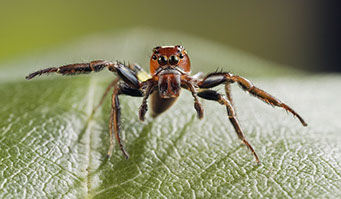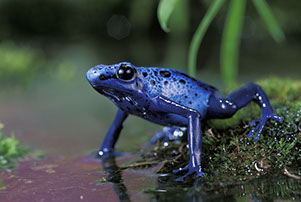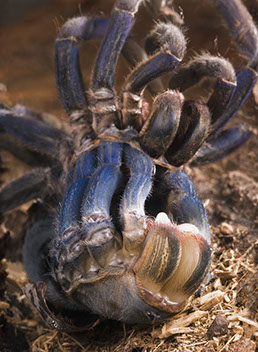
Nic Bishop
Author and Photographer
of Nature Books for Children
Photos
It is easy to think that photography is fast. After all, you press the shutter button and the photograph is completed in 1/100th of a second. But, it is all the planning and preparation beforehand that takes the time. Each photographic subject I work on is like a whole new adventure. There are new things to learn, technical problems to overcome, and days or even weeks of work to get the results I want. In fact, there have been occasions when it has taken me longer to take just one particularly difficult photograph for a book than it has to research and write the entire text.
I work in two quite different photographic styles. One is a fairly controlled and methodical style in which I use multiple flash guns to create my lighting, either out in the field or else in the studio. This is very time consuming work, which I mostly use for my close-up photographs of small animals. It takes lots of patience and attention to detail as I study and work on each subject in turn. The other photographic style is a more classical way of working. This happens when I go on an expedition to a remote part of the world, such as for my “Scientist in the Field” series of books. In this case, things are much less planned. I am in a situation that is foreign, uncertain, and often very difficult. Photo-opportunities tend to “happen” and I have to work fast to document them. At the same time, the breadth of subjects I cover may be wide. For example, on any one day I may photograph landscapes, people, close-ups and wildlife.
Close-up Photography
Close-up photography is a favorite of mine. I love to lose myself in the secret world of my subjects and imagine myself as tiny as an ant crawling through a forest of moss, to encounter them on their terms. Photographing small, active animals requires flash and I use four or more, which I finesse endlessly to pick out the best in my subject. What I love to see is fine textural details, like the micro hairs on a spider’s legs or the feint sheen on a frog’s skin, which only show up with really good light. I like to feel as though I could reach into the photograph and touch the subject.
Next, there is composition. A photograph is essentially two dimensional, so I carefully use both lighting and camera angle to create depth and maximize the picture’s three dimensional qualities. Then, I like to try and take viewer into the same world as the subject, by working my camera at the same level as the animal. I want to create eye to eye contact with the subject, as if you have been scaled down to its size and walked into its presence. And then there are the peripheral details to think about. I like to make sure that I leave in enough details of the subject’s miniature surrounding habitat to give a feel for the amazing world that it lives in. This may only be some tufts of soggy moss, or strand of old spider web, but creating a sense of place is very important in a photograph.



But that’s not quite the end! Ideally a photograph should be more than in focus, nicely lit, and with a good composition. I love to also capture emotion in my subject, such as when a spider dances for its mate or a frog seems pensive on a lily pad. This means a lot of waiting, watching, and studying the animal beforehand to see how it moves and expresses itself. Ultimately, when everything finally comes together, the aim is to create a photograph in which the subject appears tangible, connects emotionally with the viewer, and looks as if it cold pop right off the page.
All of this takes days or weeks of time, and even longer if there are other considerations. For example, this photograph shows a tarantula molting. You can see that it is lying on its back with its legs up in the air. The old skin is slowly coming off its legs, rather like a glove coming off your hand. The hardest part is that an adult tarantula only molts once a year, and it is all over in about two hours. So, the chances are that it will happen when you are asleep, or when you have gone down to the corner store. Then you have to wait another year and hope to catch it next time! What I did was to look after eleven tarantulas at home and check in on them every few hours. Even so, the first five managed to molt when I wasn’t looking. All I’d need to do was go away on a short errand and by the time I got back another tarantula would be proudly strutting around showing off its brand new skin. But, after almost five months, I got lucky with number six!


Text and Images - Copyright Nic Bishop
Next page